Part 33: Turn 5 - Soviet Combat Phase: Pocket Reopened, Just Barely

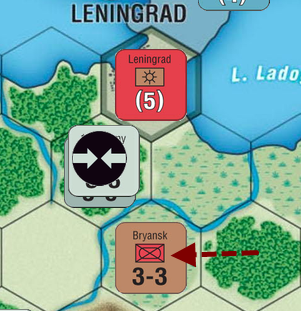
The Bryansk Front heads west to aid the beleaguered City of Lenin. Luckily, it appears its soldiers will arrive in time to respond to the fascist advance.
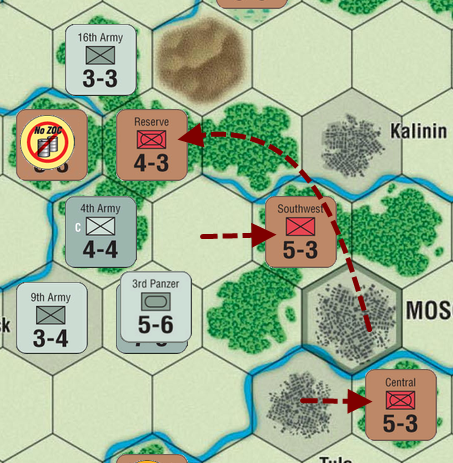
Meanwhile, their comrades around Moscow withdraw from the German line and reshuffle around the capital, taking up defensive positions again. The Reserve Front heads north to try and rescue the troops in the Velikiye Luki pocket.
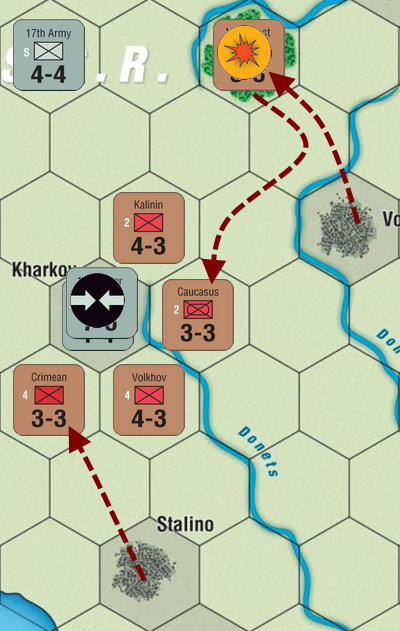
The biggest shift is in the south, where Soviet forces make a large-scale move against the Kharkov salient. The Caucasus Front is replaced in the woods around Bryansk by fresh divisions of the Northwest Front, while its battle-tested troops move south. On the other side, the Crimean Front exploits the gap in the southern approach towards the city. They smash weak German troops guarding its flanks and very soon envelop the city and cut off any potential retreat paths, as well as supply sources. This is bad news for the Germans, who are still engaged in tedious and disruptive urban combat.
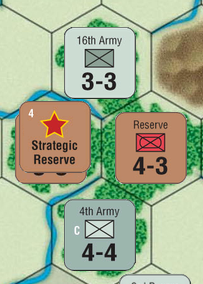
The Velikiye Luki pocket is finally evacuated, but its battered troops are hardly combat-capable. They're moved back to Strategic Reserve.
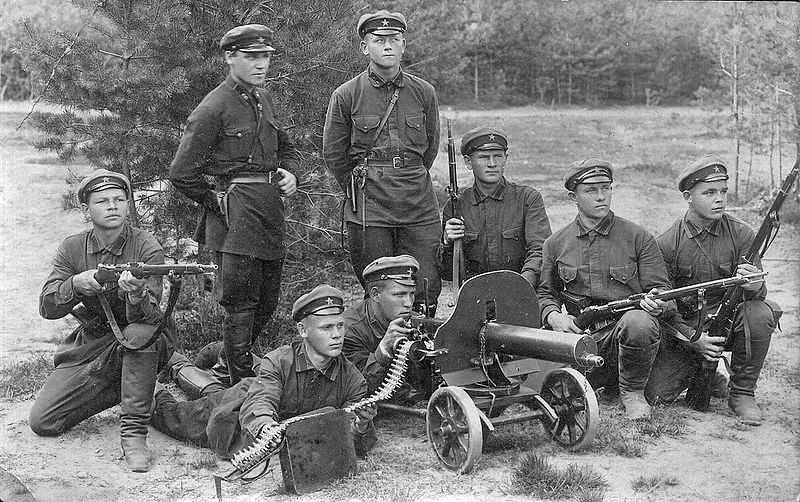
We've talked about the basic Red Army infantry weapon, the Mosin rifle, so now let's discuss something heavier. The most common Soviet heavy machine gun was the Maxim M1910, a tried and reliable weapon. It was pretty much the first generation MG, a version of Hiram Maxim's 1884 design that was in use all throughout Europe (especially in Great Britain). However, while most militaries that used the Maxim were already in the process of phasing it out by 1910 (often in favour of its derivatives, like the 1912 British Vickers MG, which stayed in service until 1968, or the German MG 08, which was occasionally used even in WWII), the Tzarist Russia was happy to adopt it pretty much unchanged: heavy, water-cooled and fed with a textile ammo belt. The purely Russian addition, however, was the Sokolov's mount: the solid (and thus contributing even further to the weapon's weight) chassis on wheels with an attached metal shield to protect the gunner (which made it pretty much necessary for someone else to direct fire and point out targets for him). The weapon remained the primary Russian infantry MG even after the revolution.
This bulky weapon is outdated by now and remains fairly costly and complicated to produce and maintain. It has one advantage, though: it is incredibly reliable. However, I'm hearing that the People's Defence Committee is already trying to speed up the development of a replacement weapon - we'll see if that gives us anything interesting.
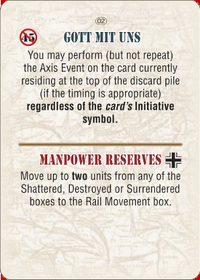
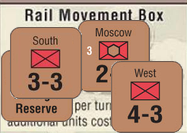
The Soviets play Manpower Reserves to get the West and Moscow Fronts out of the Destroyed/Surrendered Units Box and into the Rail Movement Box. Incidentally, three is the maximum number of troops you may have in that box.
A little late, but the Red Army troops from the Far East have finally arrived. Releasing them to General-polkovnik Fangz's command has allowed him to bolster not only the forces he had lost defending Moscow, but also rebuild the West Front, which was annihilated after it got locked in the Bialystok pocket in June 1941.
In the original timeline, the Soviet divisions defending Siberia from a possible Japanese attack were largely withdrawn to defend Moscow in December 1941. Luckily for the Soviets, they knew that Japan was not going to attack them, so those units were basically free to be repositioned elsewhere. The man who gave them that information was Richard Sorge.
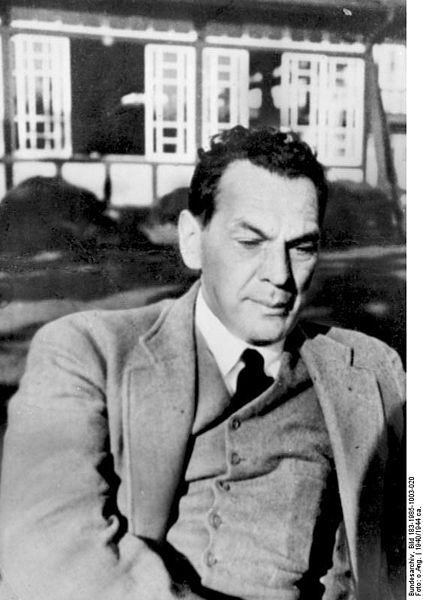
Sorge, codename "Ramsay", was a half-German, half-Russian communist born in Baku, but raised in Berlin from age 2 upwards. His paternal grandfather was Karl Marx's secretary. After serving as a conscript in the Kaiser's army in WWI, he joined the Communist Party of Germany, which got him kicked out of the university, so he started agitating in miner communities. In 1924, he arrived in Moscow, invited by the Comintern agents. From this point on he became a spy. In 1929 he moved to Soviet military intelligence and in 1931 he became the key Soviet agent in Tokio, where he pretended to be a German journalist.
He created a small network of spies, made up of both locals and foreigners, including one Japanese journalist who was often consulted as an expert by the Imperial Prime Minister Fumimaro Konoe. Sorge himself was the crucial agent there - he extracted tons of valuable intel from the German embassy, where he was considered pretty much a part of the team. German diplomats kept asking for his opinions on all kinds of matters while he partied with their wives. He was, however, under a ridiculous amount of stress and kept trying to get out. He also developed a severe case of alcoholism.
Having anticipated the Great Purge of late 1930s, he did not go back to Russia when he was called, after which the Soviet intelligence pretended as if the whole "inviting him back so that we can shoot him for imaginary treason" thing never happened and kept demanding new intelligence from him. So he obliged, giving them, among other things, the precise date of the beginning of Operation Barbarossa, which Stalin discarded as British fabrication. He also told Stalin that the Japanese were not planning on attacking the Soviet Far East, which was received a lot more positively.
However, in October 1941 he was arrested along with his entire network. The Soviets refused to exchange him for Japanese spies, declaring that the whole story was an SS plot. Sorge was hanged and his wife (who stayed in the USSR) was arrested by the NKVD for espionage and later died in a gulag. In 1964 Sorge was rehabilitated and made a Hero of the Soviet Union.

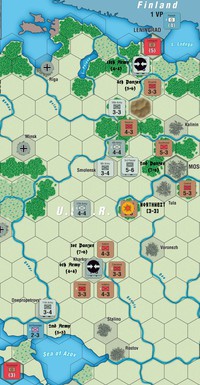
I need Target markers from Fangz, once those are in place, Herpicle may post counterblows. Afterwards Soviet commanders put in which of their units take part in which combats and where they want to advance, while Germans input their retreats. Fangz and Herpicle may also commit cards and Shock! markers to these combats (Fangz first).
The deadline for this is January 6, 7 PM GMT.
And a question to everyone (including the peanut gallery): what would you like to read about in these small history notes? Any general ideas, anything in particular, any suggestions? I sometimes have no idea what to post about and I guess that those things are a significant draw for most of non-participants.
Soviet card hand: 2 cards
Axis card hand: 3 cards